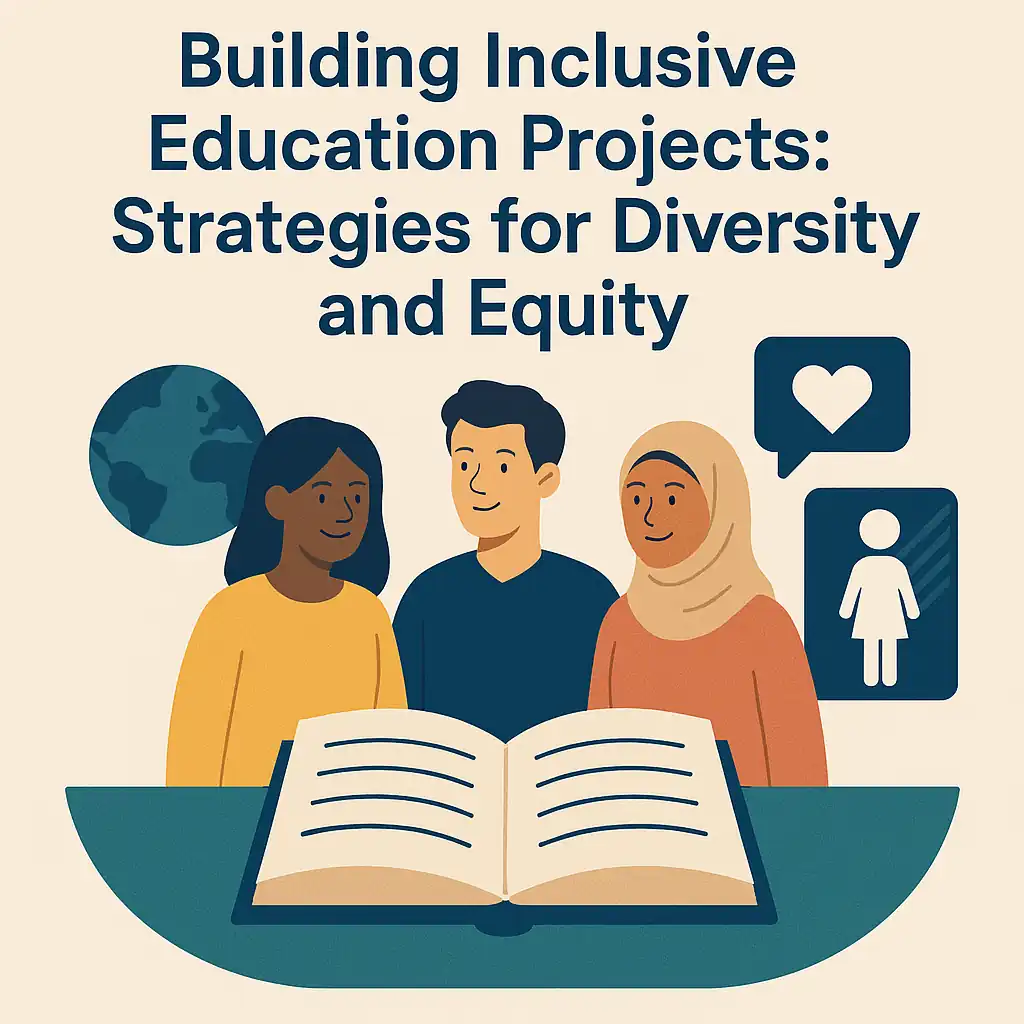Introduction
The concepts of inclusivity and equity are not merely buzzwords; they are foundational principles that guide the development and implementation of effective educational initiatives.
- Defining Inclusivity and Equity: Inclusivity in education refers to the practice of ensuring that all students, regardless of their backgrounds, abilities, or identities, have access to quality learning experiences. It encompasses a holistic approach that embraces diversity across physical, cognitive, neurological, and emotional dimensions. Equity, on the other hand, involves recognizing and addressing the different needs of students to provide them with fair opportunities for success. This means that while inclusivity aims to create a welcoming environment for all, equity focuses on the necessary adjustments and resources required to level the playing field for every learner [3][5].
- Role of Education Project Managers: Education project managers play a crucial role in fostering diversity within educational settings. They are responsible for designing and implementing projects that not only meet educational standards but also promote an inclusive culture. This involves engaging with diverse stakeholders, including families and community organizations, to ensure that the voices of all groups are heard and considered in the planning process. By actively involving these stakeholders, project managers can create educational environments that reflect the diversity of the community and address the unique challenges faced by different student populations [6][8].
- Significance of Inclusive Education Projects: Building inclusive education projects is essential for long-term success in the educational landscape. Such projects not only enhance the learning experience for all students but also prepare them for a globalized world by promoting empathy, mutual respect, and social skills. Furthermore, inclusive practices contribute to positive intergroup relations and can reduce incidents of bullying, creating a safer and more supportive environment for learning [5][8]. By prioritizing inclusivity and equity, education project managers can ensure that their initiatives lead to meaningful and sustainable outcomes for all students, ultimately contributing to a more just and equitable educational system [4][9].
Understanding Diversity and Equity in Education
This section aims to provide a foundational understanding of diversity and equity, essential for education project managers and policymakers striving to create effective and inclusive educational projects.
Dimensions of Diversity
Diversity in education encompasses a wide range of dimensions, each contributing to the richness of the learning environment. Key dimensions include:
- Race and Ethnicity: Acknowledging the varied cultural backgrounds of students is crucial for creating a respectful and inclusive atmosphere. This diversity can enhance discussions and broaden perspectives within the classroom.
- Gender: Gender diversity involves recognizing and addressing the different experiences and challenges faced by students of various genders. This includes promoting gender equity in educational resources and opportunities.
- Socioeconomic Status: Students from different socioeconomic backgrounds may have varying access to resources and support. Understanding these disparities is vital for implementing equitable educational practices.
- Disability: Inclusivity for students with disabilities requires tailored approaches to ensure they have equal access to learning opportunities. This includes adapting teaching methods and materials to meet diverse needs.
- Cognitive and Emotional Diversity: Recognizing that students have different learning styles and emotional needs is essential for creating an environment where all students can thrive.
Equity vs. Equality in Education
While equality in education refers to providing the same resources and opportunities to all students, equity focuses on fairness and the need to address individual circumstances. Equity involves:
- Tailored Support: Providing additional resources and support to students who may face barriers to learning, such as those from low-income families or with disabilities, ensures that all students have the opportunity to succeed.
- Inclusive Policies: Educational policies should reflect a commitment to equity by addressing systemic barriers and promoting practices that support diverse learners.
- Engagement with Families: Involving families in the educational process is crucial for understanding the unique needs of students and fostering a supportive learning environment.
Impact of Diverse Educational Environments on Student Outcomes
Research indicates that diverse educational settings positively influence student outcomes in several ways:
- Enhanced Social Skills: Exposure to diverse perspectives fosters empathy and mutual respect among students, which are essential skills in a globalized world. This interaction helps students develop better social skills and prepares them for future collaboration in diverse environments [8].
- Improved Academic Performance: Inclusive classrooms that embrace diversity can lead to higher academic achievement. Students benefit from varied viewpoints and collaborative learning experiences, which enhance critical thinking and problem-solving skills [9].
- Preparation for Global Citizenship: A diverse educational environment equips students with the ability to navigate and contribute to an increasingly interconnected world. Understanding and appreciating diversity prepares students to become responsible global citizens [8].
Framework for Inclusive Education Project Management
Fostering inclusivity and equity is essential for creating environments that cater to diverse learning needs and backgrounds. This framework outlines how education project managers can integrate these principles throughout the various phases of project management: initiation, planning, execution, monitoring, and closing.
1. Initiation Phase
- Define Inclusivity and Equity Goals: At the outset, project managers should establish clear objectives that prioritize inclusivity and equity. This involves identifying the specific needs of diverse student populations and ensuring that project goals reflect these considerations.
- Stakeholder Identification: Engage a broad range of stakeholders, including educators, students, parents, and community members, to gather insights and perspectives that will inform the project’s direction. This collaborative approach ensures that the project addresses the needs of all involved parties, fostering a sense of ownership and commitment.
2. Planning Phase
- Develop Inclusive Strategies: During planning, project managers should outline strategies that promote inclusivity and equity. This may include adopting universal design principles to create accessible learning environments and ensuring that instructional materials are culturally responsive.
- Set Measurable Targets: Establish specific, measurable targets for diversity and inclusion within the project. This could involve setting goals for the representation of various demographic groups in project activities and outcomes.
3. Execution Phase
- Implement Inclusive Practices: As the project is executed, it is crucial to apply inclusive practices consistently. This includes using varied engagement styles, such as individual work, paired activities, and group projects, to accommodate different learning preferences and promote cooperative learning [4].
- Continuous Stakeholder Engagement: Maintain open lines of communication with stakeholders throughout the execution phase. Regular check-ins and feedback sessions can help ensure that the project remains aligned with inclusivity and equity goals.
4. Monitoring Phase
- Assess Inclusivity and Equity Outcomes: Implement monitoring mechanisms to evaluate the effectiveness of inclusivity and equity strategies. This may involve collecting data on participant engagement and satisfaction, as well as analyzing the impact of the project on diverse student populations.
- Reflective Practices: Encourage project teams to engage in reflective practices that promote self-awareness and continuous improvement. This can help identify areas for enhancement and ensure that inclusivity remains a priority throughout the project lifecycle [6].
5. Closing Phase
- Evaluate and Celebrate Achievements: At the conclusion of the project, conduct a thorough evaluation of inclusivity and equity outcomes. Celebrate the contributions of all stakeholders and recognize the diverse cultural backgrounds and experiences that enriched the project [8].
- Document Lessons Learned: Compile insights and lessons learned regarding inclusivity and equity in project management. This documentation can serve as a valuable resource for future projects, helping to build a foundation for ongoing improvement in educational project management practices.
Strategies for Engaging Diverse Stakeholders
Engaging diverse stakeholders is crucial for the success of educational projects, particularly when aiming for inclusivity and equity. Here are actionable strategies that education project managers and policymakers can implement to effectively engage various stakeholders:
1. Identify Key Stakeholders
Understanding who the stakeholders are is the first step in fostering an inclusive environment. Key stakeholders in education projects typically include:
- Students: Their experiences and needs should be at the forefront of project planning.
- Parents: Engaging parents can provide insights into the community’s expectations and concerns.
- Educators: Teachers and administrative staff can offer valuable perspectives on the practical implications of project initiatives.
- Community Leaders: Local leaders can help bridge gaps between the school and the community, ensuring that the project aligns with community values and needs.
Identifying these stakeholders allows project managers to tailor their engagement strategies effectively, ensuring that all voices are heard and considered throughout the project lifecycle [1][5].
2. Techniques for Effective Communication and Collaboration
Effective communication is essential for stakeholder engagement. Here are some techniques to enhance collaboration:
- Two-Way Dialogue: Establish a communication framework that encourages feedback and questions from stakeholders. This can be achieved through regular meetings, surveys, and open forums [2][8].
- Diverse Communication Channels: Utilize various communication methods to reach different stakeholders. This may include newsletters, social media, community meetings, and digital platforms to ensure that information is accessible to everyone [9].
- Cultural Sensitivity: Be aware of cultural differences and tailor communication styles accordingly. This helps in building trust and ensuring that all stakeholders feel valued and understood [10].
3. Participatory Planning Processes
Incorporating participatory planning processes can significantly enhance stakeholder engagement. Here are some examples:
- Focus Groups and Town Hall Meetings: Organizing focus groups or town hall meetings allows stakeholders to share their insights and experiences directly. This participatory approach fosters a sense of ownership and commitment to the project [3][4].
- Diversity Committees: Establishing committees that include representatives from various stakeholder groups can facilitate ongoing dialogue and collaboration. These committees can help guide project decisions and ensure that diverse perspectives are integrated into the planning process [3].
- Surveys and Feedback Mechanisms: Implementing surveys to gather input from stakeholders can provide valuable data on community needs and preferences. This information can guide project goals and strategies, ensuring they are aligned with stakeholder expectations [3][6].
By employing these strategies, education project managers can create a more inclusive environment that values the contributions of all stakeholders. This not only enhances the effectiveness of educational projects but also promotes a culture of equity and belonging within the educational community.
Culturally Responsive Curriculum Development
Fostering inclusivity and equity is paramount. One of the most effective ways to achieve this is through the implementation of a culturally responsive curriculum. This approach not only acknowledges the diverse cultural backgrounds of students but also integrates these perspectives into the learning environment, thereby enhancing educational outcomes for all learners.
Defining Culturally Responsive Teaching
Culturally responsive teaching (CRT) is an educational framework that emphasizes the importance of recognizing and valuing students’ diverse cultural backgrounds. It aims to create a learning environment where all students feel respected and included, which is essential for promoting equity in education projects. By embracing students’ customs, characteristics, experiences, and perspectives, educators can utilize these elements as tools for more effective instruction, ultimately leading to improved engagement and academic success [3][5].
Strategies for Developing a Culturally Responsive Curriculum
To develop a curriculum that reflects diverse perspectives, education project managers can employ several key strategies:
- Know Your Students: Understanding the cultural backgrounds, interests, and learning styles of students is crucial. This can be achieved through surveys, discussions, and one-on-one conversations, allowing educators to tailor their approaches to meet the needs of all learners [12].
- Diversify Learning Materials: Incorporating texts, media, and perspectives from a wide range of cultures and ethnicities is essential. This not only enriches the curriculum but also makes academic content more relatable to students’ lived experiences [12].
- Engage Families and Communities: Involving parents, community leaders, and students in the curriculum development process ensures that the content is authentic and relevant. This collaboration fosters a sense of ownership and respect for diverse cultural narratives [11].
- Flexible Teaching Strategies: Implementing flexible and inclusive teaching strategies allows educators to adapt their methods to accommodate various learning styles and cultural contexts. This adaptability is vital for creating an equitable learning environment [14].
Examples of Successful Culturally Responsive Curricula
Several educational institutions have successfully implemented culturally responsive curricula, demonstrating the effectiveness of this approach:
- Multicultural Literature Programs: Schools that have integrated multicultural literature into their reading programs have seen increased student engagement and a deeper understanding of diverse perspectives. For instance, using books that reflect the cultural backgrounds of students can foster discussions about identity and community [10].
- Culturally Relevant Science Curriculum: Some educational projects have developed science curricula that incorporate indigenous knowledge and practices. This not only validates the cultural heritage of students but also enriches the scientific discourse by including diverse methodologies and viewpoints [10].
- Community-Based Learning Initiatives: Programs that connect classroom learning with community issues have proven effective in promoting inclusivity. By addressing real-world problems that resonate with students’ cultural contexts, these initiatives enhance relevance and engagement in the learning process [10].
Assessing and Measuring Inclusivity and Equity
As education project managers and policymakers strive to create environments that cater to diverse student needs, it becomes essential to assess and measure the effectiveness of these initiatives. Here are some key strategies and tools to consider:
Assessment Tools and Metrics for Evaluating Inclusivity
- Diagnostic Tools: Developing a comprehensive diagnostic tool is crucial for measuring inclusivity. This involves defining inclusivity, identifying relevant indicators, and creating methodologies that reflect the realities of educational environments. Such tools can help in understanding the various dimensions of inclusivity within educational systems [2].
- Input-Process-Outcome Model: This model can be applied to analyze different policy areas within education systems. By focusing on inputs (resources and strategies), processes (teaching and learning interactions), and outcomes (student engagement and achievement), project managers can gain insights into the effectiveness of their inclusivity efforts [3].
- Checklists and Criterion-Referenced Probes: These instruments can assess basic skills, classroom interactions, and effective management practices. They provide a structured way to evaluate how well educational practices meet inclusivity standards [4].
- Data-Backed Benchmarks: Establishing realistic benchmarks allows project managers to track progress over time. These benchmarks serve as reference points for setting achievable goals, making the journey toward inclusivity more focused and structured [6].
Importance of Feedback Loops and Continuous Improvement
Creating an inclusive educational environment is not a one-time effort; it requires ongoing assessment and adaptation. Implementing feedback loops is essential for continuous improvement. This involves:
- Regular Assessments: Conducting periodic evaluations of inclusivity initiatives helps identify areas for improvement and measure the effectiveness of interventions aimed at enhancing diversity [7].
- Stakeholder Feedback: Engaging students, parents, and educators in the feedback process ensures that diverse perspectives are considered, leading to more effective and inclusive practices.
- Iterative Processes: Utilizing feedback to refine strategies and practices fosters a culture of continuous improvement, allowing educational projects to adapt to changing needs and contexts.
Challenges in Implementing Inclusive Education Projects
Implementing inclusive education projects presents a unique set of challenges for education project managers. These challenges can hinder the effectiveness of initiatives aimed at promoting diversity and equity within educational settings. Below are some common barriers and strategies to overcome them, along with the importance of resilience and adaptability in project management.
Common Barriers to Inclusivity and Equity
- Budget Constraints: Limited financial resources can restrict the ability to provide necessary materials, training, and support for inclusive practices. This often leads to inadequate facilities and resources for students with diverse needs [10].
- Resistance to Change: Stakeholders, including educators and parents, may resist new inclusive practices due to entrenched beliefs or fear of the unknown. This resistance can stem from a lack of understanding of the benefits of inclusivity [11].
- Inadequate Teacher Training: Many educators may not have received sufficient training in inclusive teaching methods, which can lead to ineffective implementation of inclusive practices. This gap in skills can create barriers for students with disabilities or diverse learning needs [11][15].
- Societal Norms and Attitudes: Societal perceptions regarding disabilities and inclusivity can influence the implementation of inclusive education. Negative attitudes can create an environment that is not conducive to diversity and equity [11].
- Lack of Support and Resources: Effective inclusive education requires appropriate resources, including specialized instructional materials and support staff. A lack of these resources can significantly impede project success [10].
Strategies for Overcoming Challenges
- Budget Planning and Resource Allocation: Education project managers should prioritize budget planning that allocates funds specifically for inclusive practices. Seeking grants, partnerships, and community support can also help supplement financial resources [10].
- Stakeholder Engagement and Education: Engaging stakeholders through workshops and informational sessions can help alleviate resistance to change. By demonstrating the benefits of inclusive education, project managers can foster a more supportive environment [11].
- Professional Development for Educators: Providing ongoing professional development opportunities focused on inclusive teaching strategies is essential. This training should be tailored to meet the specific needs of educators and the diverse student population they serve [14].
- Promoting Positive Societal Attitudes: Initiatives aimed at changing societal perceptions about disabilities and inclusivity can be beneficial. Campaigns that highlight success stories and the importance of diversity in education can help shift attitudes [11].
- Building a Supportive Network: Establishing a network of support among educators, administrators, and community members can facilitate resource sharing and collaborative problem-solving. This network can also provide emotional support and encouragement during challenging times [10].
Importance of Resilience and Adaptability
In the face of these challenges, resilience and adaptability are crucial traits for education project managers. The ability to pivot strategies in response to unforeseen obstacles can make a significant difference in the success of inclusive education projects. Embracing a mindset that values flexibility allows project managers to navigate complexities and maintain focus on the ultimate goal of providing equitable education for all students [7][12].
By recognizing and addressing these challenges, education project managers can create more inclusive and equitable educational environments that benefit all learners.
Conclusion
In the realm of educational project management, the significance of inclusivity and equity cannot be overstated. As project managers and policymakers, it is imperative to recognize that fostering an inclusive environment not only enhances the learning experience for all students but also contributes to a more just and sustainable society. By prioritizing diversity and equity, we can ensure that every student, regardless of their background or abilities, has equitable access to quality education and meaningful engagement in the learning process.
To achieve this, education project managers should actively adopt the strategies discussed throughout this blog. This includes conducting equity audits to identify gaps in inclusivity, engaging in open discussions about team dynamics, and implementing practices that promote diverse perspectives within project teams. By being aware of unconscious biases and using inclusive language, project managers can create a culture that values every voice and fosters collaboration among diverse stakeholders.
Moreover, it is essential to commit to ongoing education and advocacy for diversity and equity in educational settings. This commitment should extend beyond individual projects and into the broader educational landscape, influencing policies and practices that shape the future of education. By taking real action towards inclusivity, education project managers and policymakers can lead the way in transforming educational systems to be more equitable and inclusive for all.
In conclusion, let us embrace the responsibility to champion diversity and equity in our educational projects. Together, we can create an environment where every student thrives, and every voice is heard, paving the way for a brighter and more inclusive future in education.
Find out more about Shaun Stoltz https://www.shaunstoltz.com/about/.
This post was written by an AI and reviewed/edited by a human.



